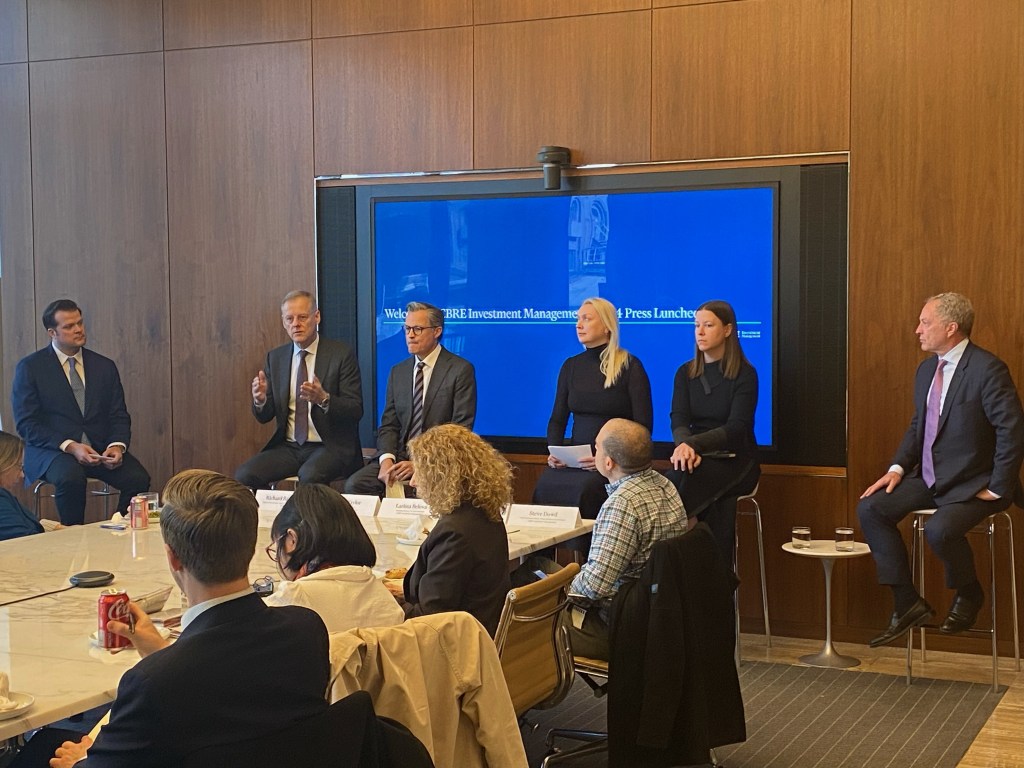CRE Experts See Opportunities Ahead
Despite the muddy capital markets picture, panelists at CBRE Investment Management’s press luncheon were largely upbeat about fundamentals.

Experts at CBRE Investment Management’s first annual press luncheon were optimistic about the state of commercial real estate investment and development in 2024 and beyond, even in the face of longstanding secular challenges that numerous asset classes face.
Economic outlook: Soft landing entirely possible
Despite the decades-high interest rates, CBRE Global Chief Economist Richard Barkham was bullish about both the economy’s prospects and its impact on asset class fundamentals. Pointing to the more than threefold decline in core inflation, Barkham sees a soft landing as “very much in the cards.”
Additionally, government spending and containment of the successive bank failures in March of 2023 helped further stimulate the economy. In the same vein, legislation such as the CHIPS and Inflation Reduction Acts have spurred a great deal of construction activity and investment, and trickled into the “resilience of the consumer,” through the development of projects such as chip fabrication and electric vehicle production plants, Barkham explained.
READ ALSO: What’s Boosting CRE Investor Confidence Now: Survey
But how does all of this affect commercial real estate asset performance in real time? Highlighting five consecutive quarters of positive net absorption in the industrial and retail sectors, Barkham believes that the “discourse focuses on office, but for the majority of sectors, the fundamentals are positive.” Speaking of office, Barkham also pointed out the fact that 80 percent of office properties remain income-producing.
For capital markets, however, the business appears to already be in a recession, going back to the middle of 2022. Total transactions in 2023 fell by 52 percent year-over-year to $81 billion, according to the firm’s internal data. Pointing to the roughly $2.2 trillion in refinancing loans that are maturing before 2028, Barkham believes that “the next 24 months are going to be tricky,” especially as some lenders, such as regional banks, have all but exited the market. The office sector in particular is likely to suffer further as more properties come under distress. “Some capital is available, but some losses are going to be incurred by owners and lenders of office real estate,” Barkham added.
Still, the interest rate cuts likely to take place later this year should cause capital markets to experience a “slow revival,” according to Barkham.
Industrial’s vintage year
Despite the high costs and oftentimes undesirable available capital, secular, intangible changes impacting numerous commercial asset classes still make them strong investments, even in the current rate environment. For industrial, the construction of technologically advanced logistics space is a must, given escalating geopolitical tensions and environmental risks. “We not only need more logistics stock, but modern, efficient stock,” capable of meeting the just-in-time delivery needs of American consumers and businesses, explained Shane Taylor, the firm’s Americas head of research.
Larissa Belova, managing director of U.S. Core Strategies views industrial as a core asset, giving the significantly rising rents, “robust leasing activity” and “tremendous desire to invest” despite “distress in the capital stack.” “It’s going to be a great vintage, and we are at the beginning of the next supercycle,” Belova added.
Innovations and disruptions
On the development end, this desire to meet demand is easier said than done. The industrial sector, as Taylor observed, is “poised for a lot of disruption,” given technological overhauls in infrastructure, robotics and amenities. Moreover, the average age of an industrial property in the U.S. is 40 years, according to Mary Lang, head of Americas direct logistics strategies & portfolio manager.
With this in mind, “the greatest amenity going forward is going to be the availability of power,” given the fact that most facilities require 8 amps at a minimum to power material handling systems and robotics, to say nothing of electric vehicle chargers. Lang believes that the solution lies in the implementation of solar panels and on-site battery storage, which not only increase energy efficiency and accommodational capabilities but their resiliency as well. For upscaling to 8 amps, “You can’t just call a utility,” Lang observed.
Industrial demand is not the only trend influencing a major technical overhaul of the built world and its surroundings. Equally important to the volume and delivery of energy for new facilities and others is its sustainability and impact on the environment.
Steve Dowd, chief investment officer of private infrastructure strategies, sees a widespread transition toward a digital economy as motivating an “energy transition toward decarbonization and electrification,” a necessity given large-scale development of data centers, mobile phone towers and fiber networks. “Nobody is building a coal plant in the developed world, and corporations want clean power,” Dowd concluded.







You must be logged in to post a comment.